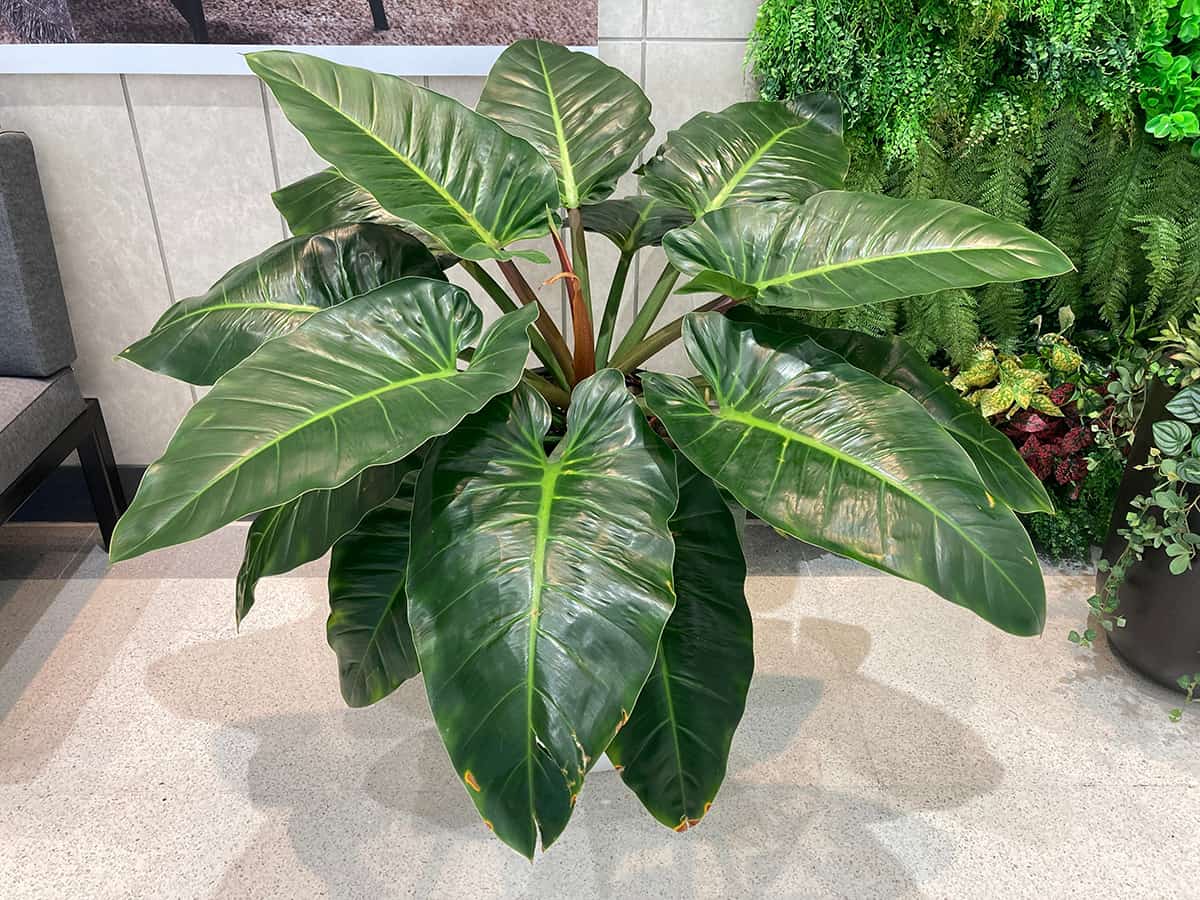Stepping into a cozy living room, your eyes are instantly drawn to a large, leafy Elephant Ear plant in the corner. Its broad, green leaves fan out like a natural umbrella, making the space feel more alive and inviting. This scene is a common wish for those looking to add a touch of nature to their indoor spaces.
Houseplants with big leaves aren’t just decor; they’re like quiet friends that brighten up your home and clean the air, all while asking for little in return. Whether you’re a busy professional or a homebody, these green giants can fit into your life, adding charm and a breath of fresh air to any room.
Table of Contents
- Fiddle Leaf Fig (Ficus Lyrata)
- Monstera Deliciosa
- Bird Of Paradise (Strelitzia Reginae)
- Elephant Ear (Alocasia Spp.)
- Philodendron ‘Xanadu’
- Rubber Plant (Ficus Elastica)
- Swiss Cheese Plant (Monstera Adansonii)
- Giant Bird Of Paradise (Strelitzia Nicolai)
- Banana Plant (Musa Spp.)
- Calathea Orbifolia
- Peace Lily (Spathiphyllum ‘Sensation’)
- Anthurium ‘Faustino’s Giant’
- Split-Leaf Philodendron (Philodendron Bipinnatifidum)
- Cast Iron Plant (Aspidistra Elatior)
- Ruffled Fan Palm (Licuala Grandis)
Fiddle Leaf Fig (Ficus Lyrata)
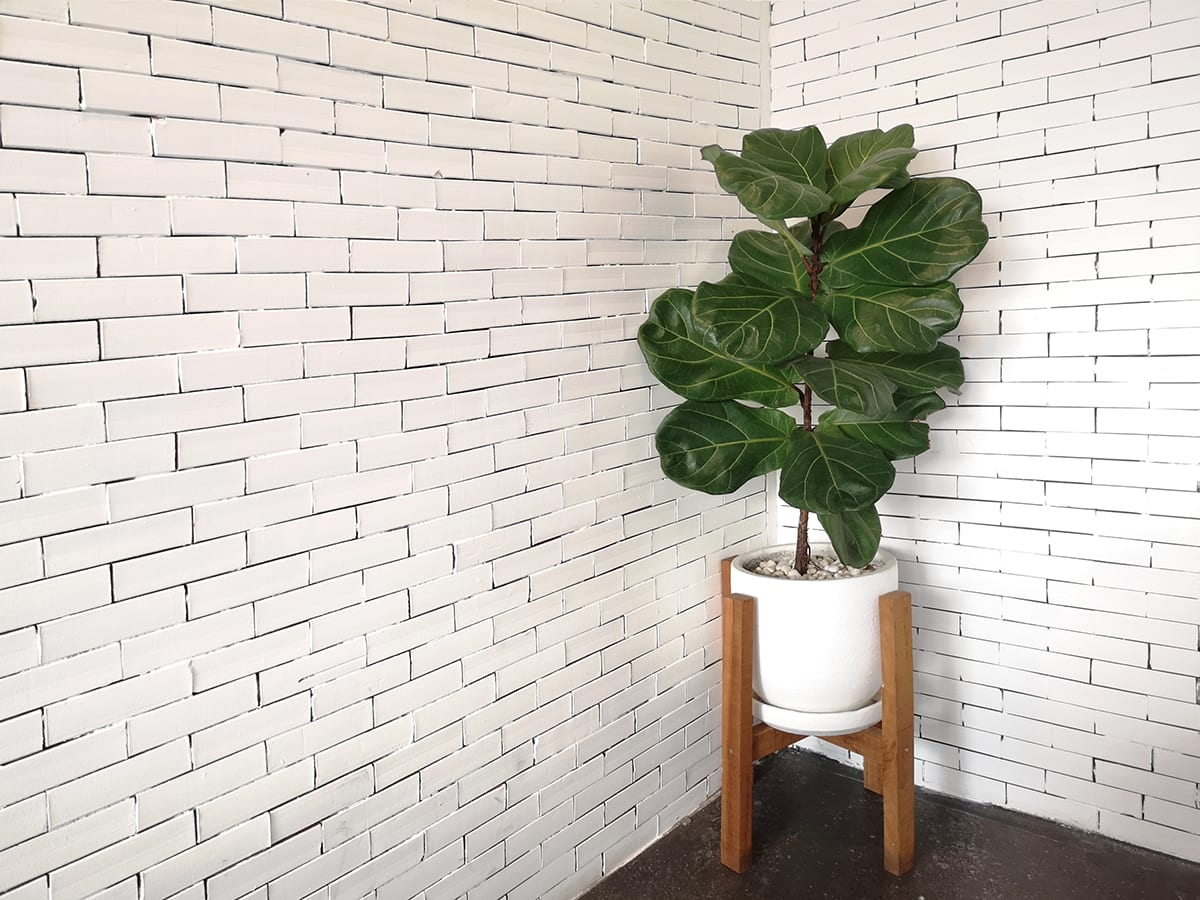
The Fiddle Leaf Fig, known scientifically as Ficus lyrata, is a vibrant houseplant with expansive leaves. You can easily recognize it by its broad, green leaves, shaped like violins. In homes, it often reaches a height between 2 and 10 feet, making a significant visual impact.
Fiddle Leaf Fig prefers indirect sunlight and desires well-draining soil. When the top inch of soil feels dry, it’s time to water. Your plant will stay healthy with less frequent, thorough waterings.
The Fiddle Leaf Fig can be sensitive to its environment. Temperature fluctuations and drafts may lead to leaf loss. Aim to keep your plant in a stable setting with temperatures between 60-75°F (15-24°C).
Enhance your living space with a Fiddle Leaf Fig. It’s a statement piece known not just for its size but for its ability to refresh any home decor. For continued growth and health, fertilize once or twice a year, during spring or summer.
Monstera Deliciosa
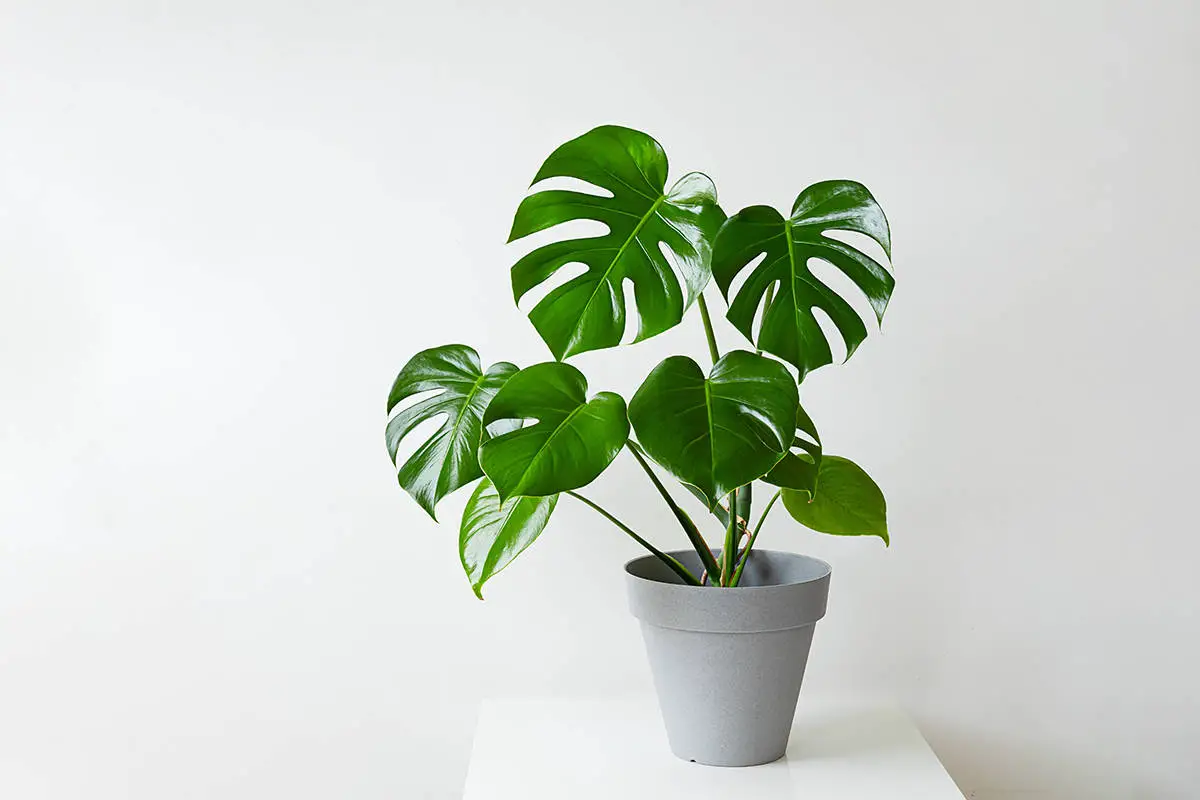
Monstera deliciosa, known as the Swiss cheese plant, features large, glossy leaves with signature splits. Your space can feel like a lush jungle with one of these plants. Native to rainforests of Central America, it thrives in warm, humid conditions.
You should provide your monstera with bright, indirect light. Water it when the top inch of soil feels dry. Overwatering can lead to root rot, damaging the plant.
This plant’s leaves can grow large, up to 3 feet wide. It may develop aerial roots to support its growth. If you provide a stake or moss pole, it can climb to impressive heights.
Keep the leaves clean by wiping them with a soft, damp cloth. This routine maintains their shine and aids photosynthesis. Monsteras are generally low-maintenance, making them ideal for busy plant lovers.
Bird Of Paradise (Strelitzia Reginae)
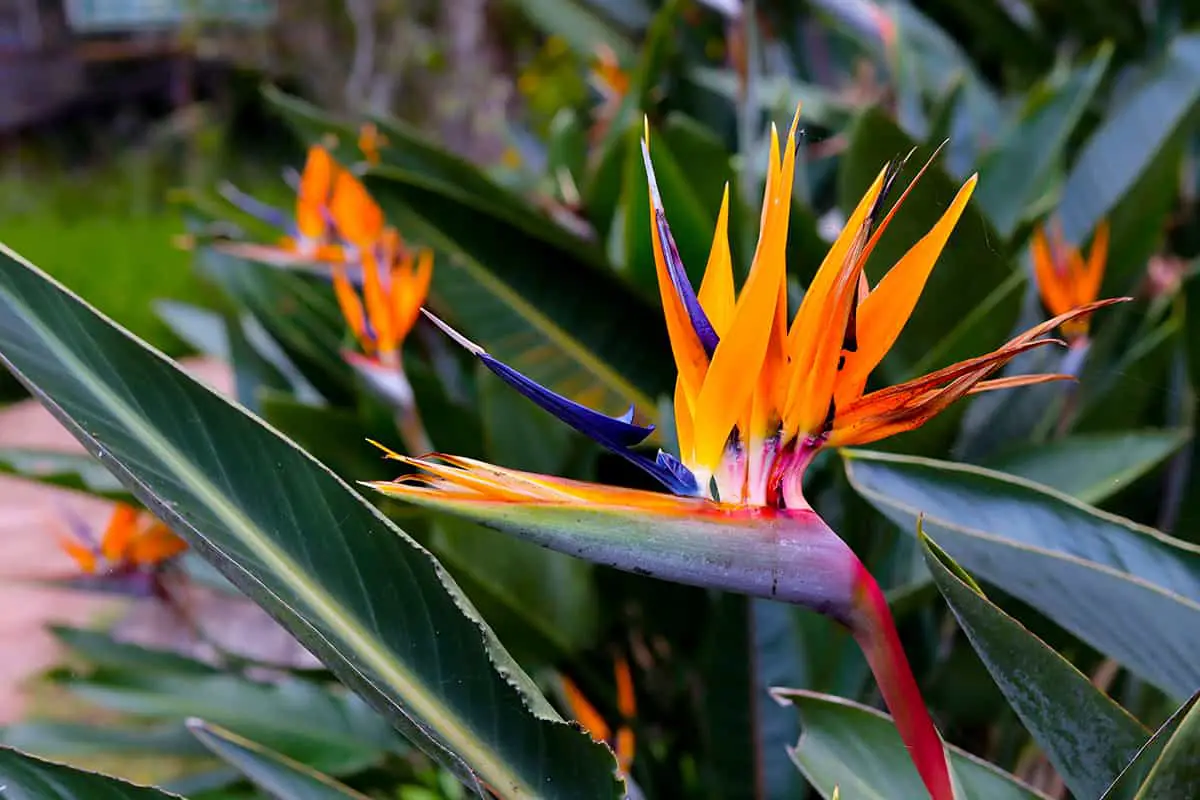
The Bird of Paradise graces your home with its large, tropical leaves. Native to South Africa, this plant thrives indoors with proper care. Its big leaves emerge from ground-level stems, forming a lush, green focal point.
Bright light is essential for your Bird of Paradise, so positioning it by a sunny window is ideal, though it’s important to shield it from direct, harsh sunlight to prevent leaf scorch.
When it comes to watering, maintaining a balance is key: the soil should be kept moist but not waterlogged. Ensure the top inch of soil dries out before watering again to promote healthy growth.
The Bird of Paradise is renowned for its flowers, which burst forth in a display of orange and blue hues, resembling a vibrant bird in flight. These blooms, emerging from broad leaves, are rare indoors but add an element of excitement to the anticipation of their appearance.
This plant can grow quite large, reaching up to five feet in both height and width, necessitating ample space in spacious rooms or large hallways. Regularly rotating your Bird of Paradise ensures even growth and leaf development, keeping it looking its best.
Temperature-wise, the Bird of Paradise thrives in warmth, preferring conditions around 65–70°F (18–21°C). It’s crucial to protect it from drafts and sudden temperature changes to maintain its health and vitality.
Elephant Ear (Alocasia Spp.)
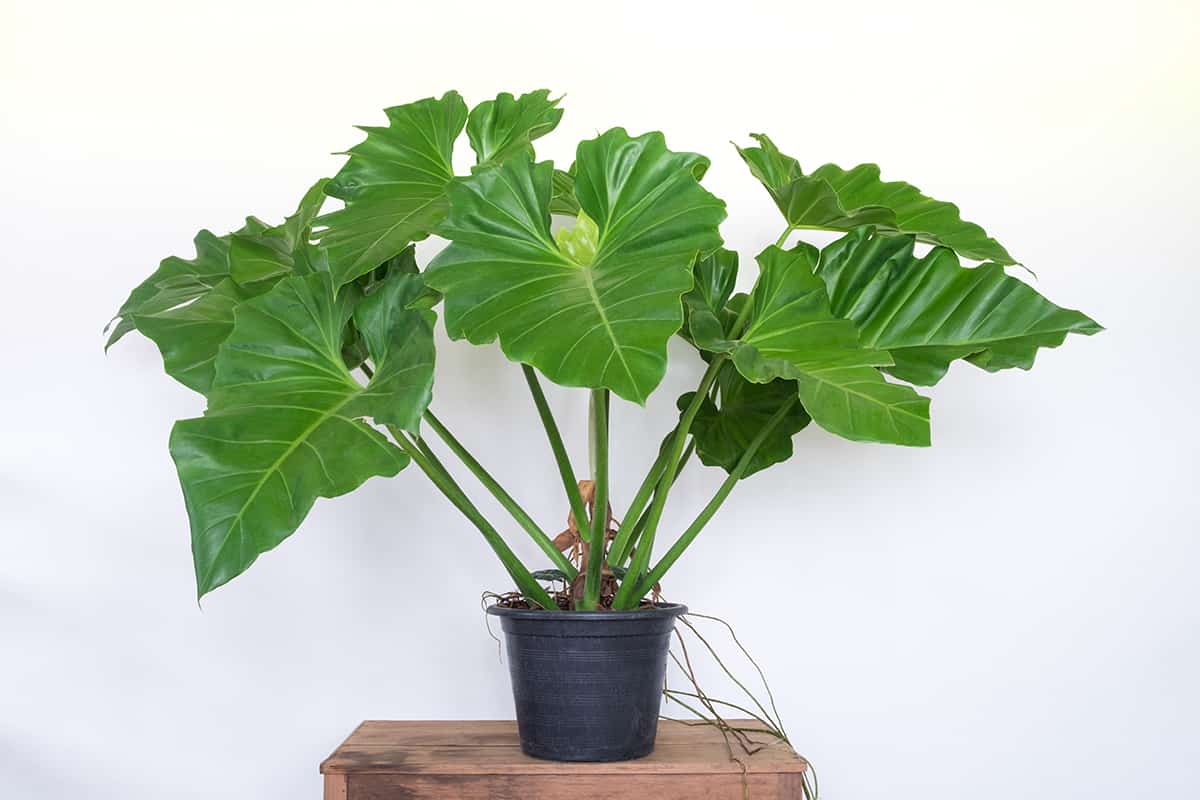
The Elephant Ear plants get their name from the shape and size of their leaves, which resemble an elephant’s ear. These Alocasia species, known for their large and arrow-shaped foliage, can elevate the look of your indoor space.
When you choose an Elephant Ear, you are selecting a tropical perennial. These plants thrive in environments that mimic their native habitat. They prefer bright, indirect light and consistent moisture. Be careful not to overwater, as this can lead to root rot. The Elephant Ear enjoys high humidity, which you can provide with regular misting or a humidity tray.
To ensure vigorous growth, feed your Elephant Ear with a balanced fertilizer during the growing season. This plant can be sensitive to chemicals, so use organic options when possible. Do not let the temperature drop below 60°F, as Elephant Ears are cold-sensitive.
Remember that the leaves of Elephant Ear plants can grow quite large, up to a few feet in length. Make sure you have enough space for your plant to thrive. Its leaves are not only large but also feature prominent veins and a variety of colors and patterns.
Philodendron ‘Xanadu’
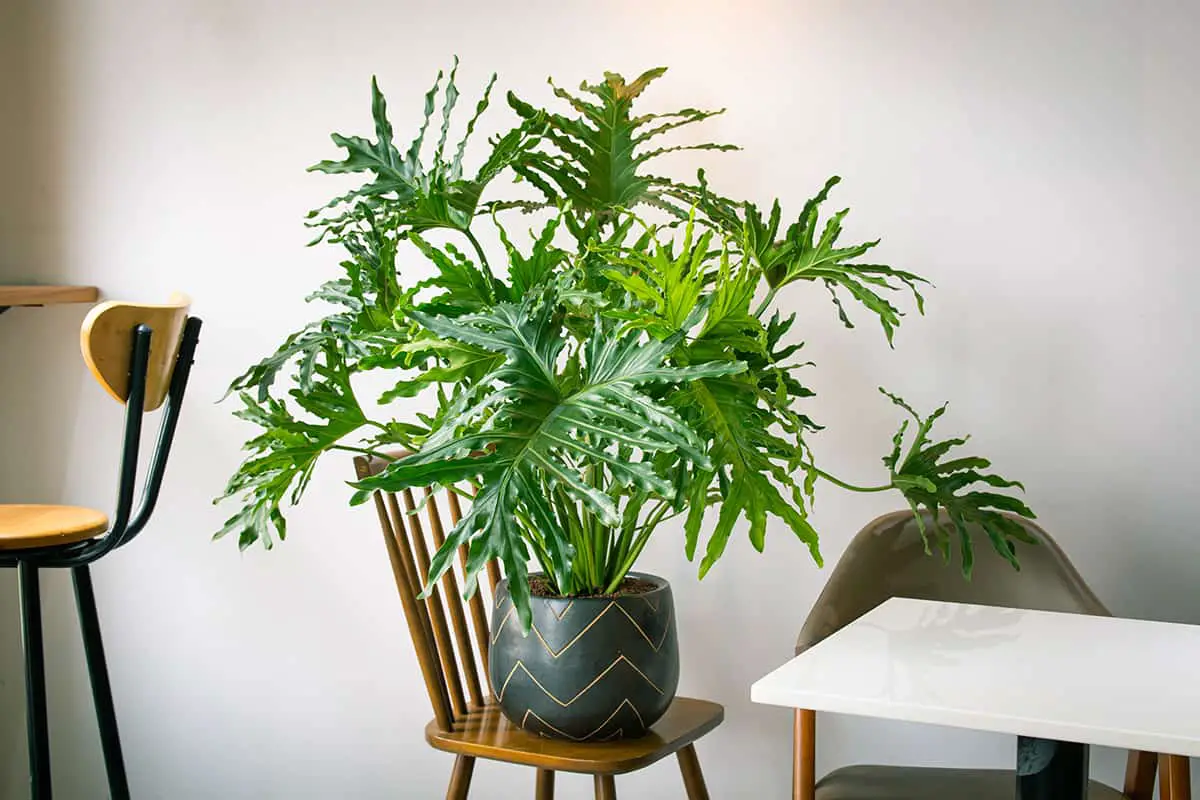
The Philodendron ‘Xanadu’, a tropical plant, brings a lush look indoors. Its large, glossy leaves have a bold green color and distinct lobed edges.
Philodendron ‘Xanadu’ prefers bright, indirect light and regular watering. However, ensure the soil is well-draining to prevent root rot. This plant thrives in houseplant-friendly conditions with warm temperatures.
Philodendron ‘Xanadu’ remains compact compared to other large-leafed houseplants. Typically, it grows 2 to 4 feet tall. Its manageable size makes it suitable for various spaces in your home.
To maintain its striking appearance, clean the leaves andwipe them gently with a damp cloth, which helps the Philodendron ‘Xanadu’ absorb more light and remain healthy.
Rubber Plant (Ficus Elastica)
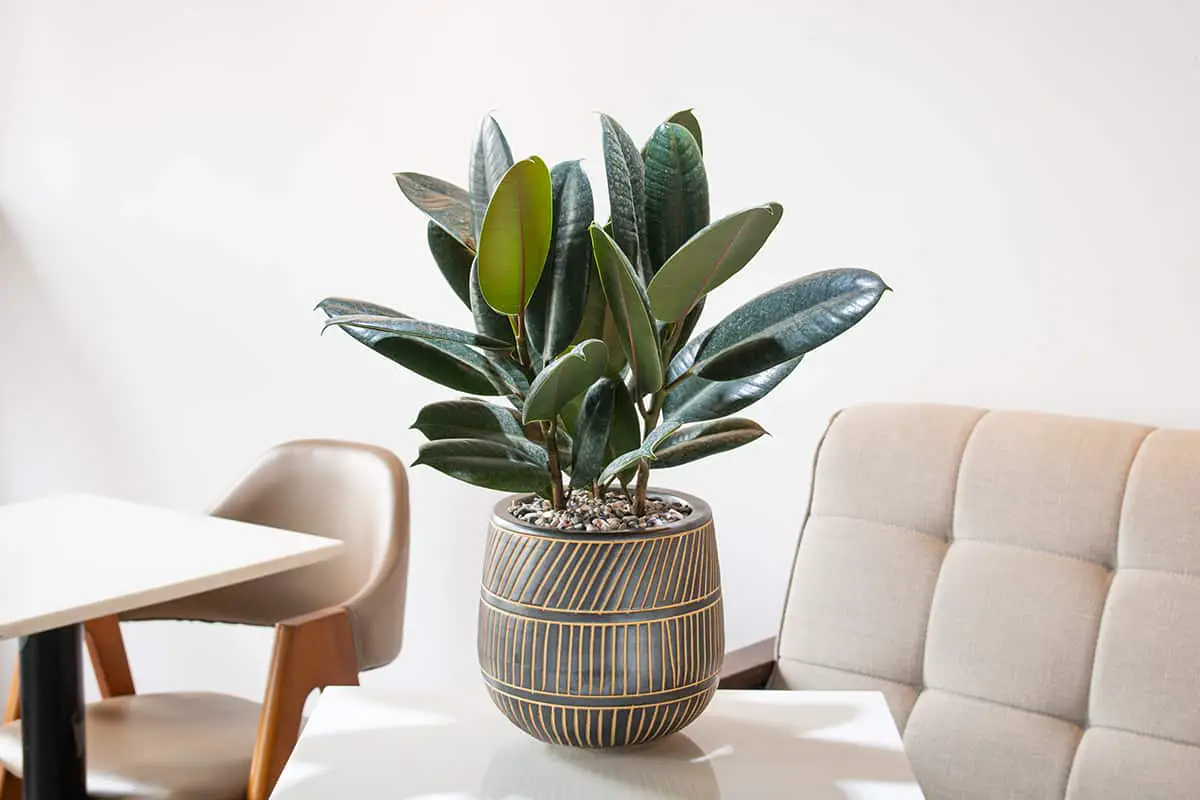
The Rubber Plant, scientifically known as Ficus elastica, features broad, glossy leaves
Your Rubber Plant prefers bright conditions but adapts to low light. Ideal places include near an east-facing window where it gets morning light. Its large leaves collect dust, so clean them with a damp cloth to keep the plant healthy.
Keep the soil moist for your Ficus elastica, but avoid overwatering. It’s tolerant of a range of humidity levels found in homes. Be sure to protect it from cold drafts and temperatures below 55°F, which can harm the plant.
Ficus elastica grows well at average room temperatures. Aim for a range between 60 to 65 °F at night and 75 to 80 °F during the day. This ensures a healthy growth environment for your Rubber Plant.
Remember, the Rubber Plant is sensitive to moving. Once you find a good spot, try not to move it too often.
Swiss Cheese Plant (Monstera Adansonii)
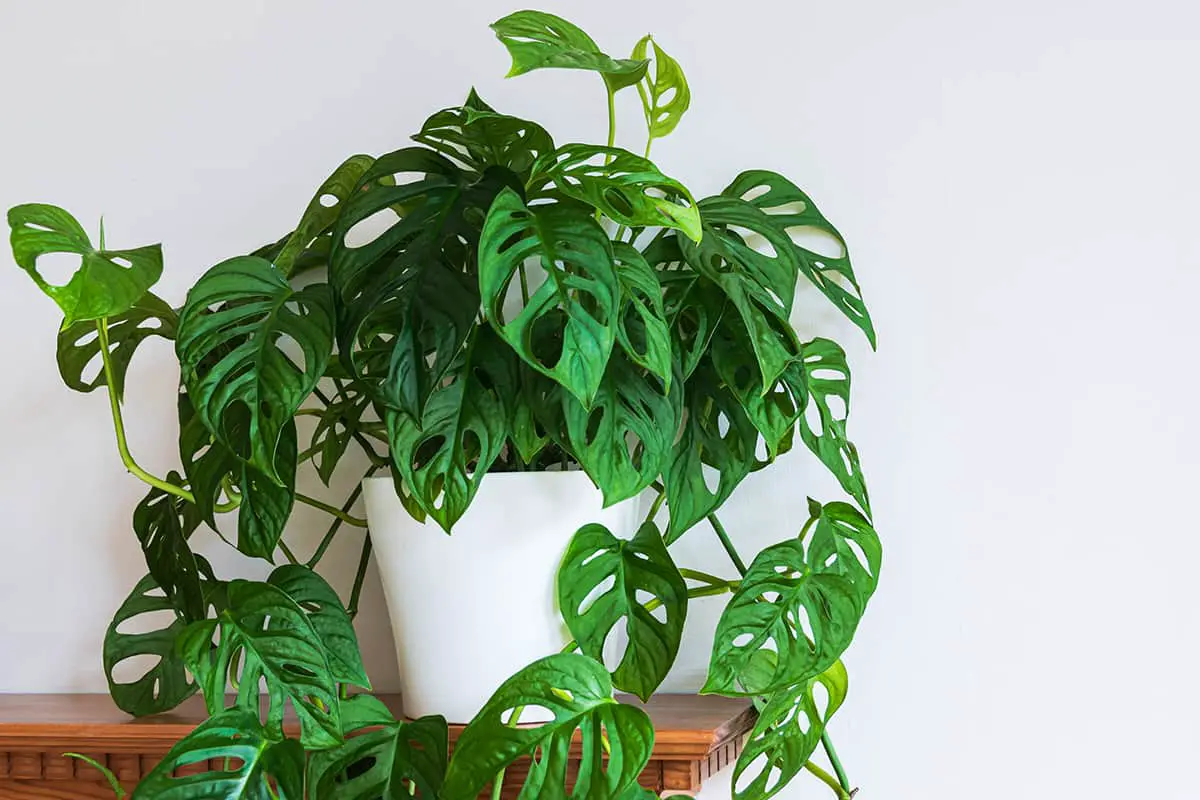
The nickname as the Swiss Cheese Plants comes from the plant’s leaves. They have unique perforations that resemble holes in Swiss cheese.
Monstera adansonii thrives in well-draining soil. You should place it in a bright room, avoiding direct sunlight. This promotes growth without burning the leaves. The plant also prefers humid environments which mimic its native jungle habitat. You can increase humidity with regular misting.
You will find Monstera adansonii a low-maintenance houseplant. It requires watering only when the top inch of soil feels dry. Overwatering can harm the plant, so it’s important to monitor soil moisture carefully. It can reach lengths of several feet, given time and space to climb.
Giant Bird Of Paradise (Strelitzia Nicolai)

The Giant Bird of Paradise, Strelitzia nicolai, attracts attention with its towering height and large leaf structure as standouts. Native to South Africa, this species thrives in warm climates.
This plant showcases broad, banana-like leaves. These can reach a width of up to 10 feet. Over time, your Giant Bird of Paradise may achieve a height of 20 to 30 feet, resembling a tropical canopy.
The plant flourishes under bright light, making southern or eastern exposure windows ideal locations when grown indoors. Healthy growth is further supported by well-draining soil, ensuring the roots are not waterlogged.
In terms of care, while it requires regular watering to establish itself, it becomes drought-tolerant over time, showcasing its resilience. Additionally, its minimal invasive potential makes it a safe and responsible choice for your garden. To maintain its best appearance, removing old leaves is recommended, keeping it looking fresh and vibrant.
The plant is distinguished by its unique white blooms, which add an exotic touch to your environment. Each flower, resembling a white bird in flight, contributes to its descriptive and evocative name, captivating onlookers with its natural beauty and contributing to the allure of your garden or indoor space.
Banana Plant (Musa Spp.)

Your Banana Plant starts with a thick green pseudo-stem, its leaves spiraling outward. These are not true stems, but they create a robust, tree-like appearance.
Each leaf of Musa spp. can grow quite long, adding a tropical flair to your space. The leaves may reach impressive lengths, and their broad nature collects light efficiently. They can arch gracefully from the top of the pseudo-stem as the plant matures.
You will find these plants are a remarkable addition to large indoor areas. They need a bright spot to thrive and prefer a warm room without drafts. If you care for them well, you may even see your Banana Plant flower, although fruiting is rare indoors.
One more thing to consider is their size. They grow tall, so ensure you have ample space. If not, look for a dwarf variety. Some can grow in pots, but others can reach over 30 feet, so choose according to your room size.
Care is straightforward. Keep the soil moist and watch out for cold drafts. In colder regions, they must be overwintered indoors. They enjoy a wide pH range in the soil, and they make for a hardy, evergreen presence in your home.
Calathea Orbifolia
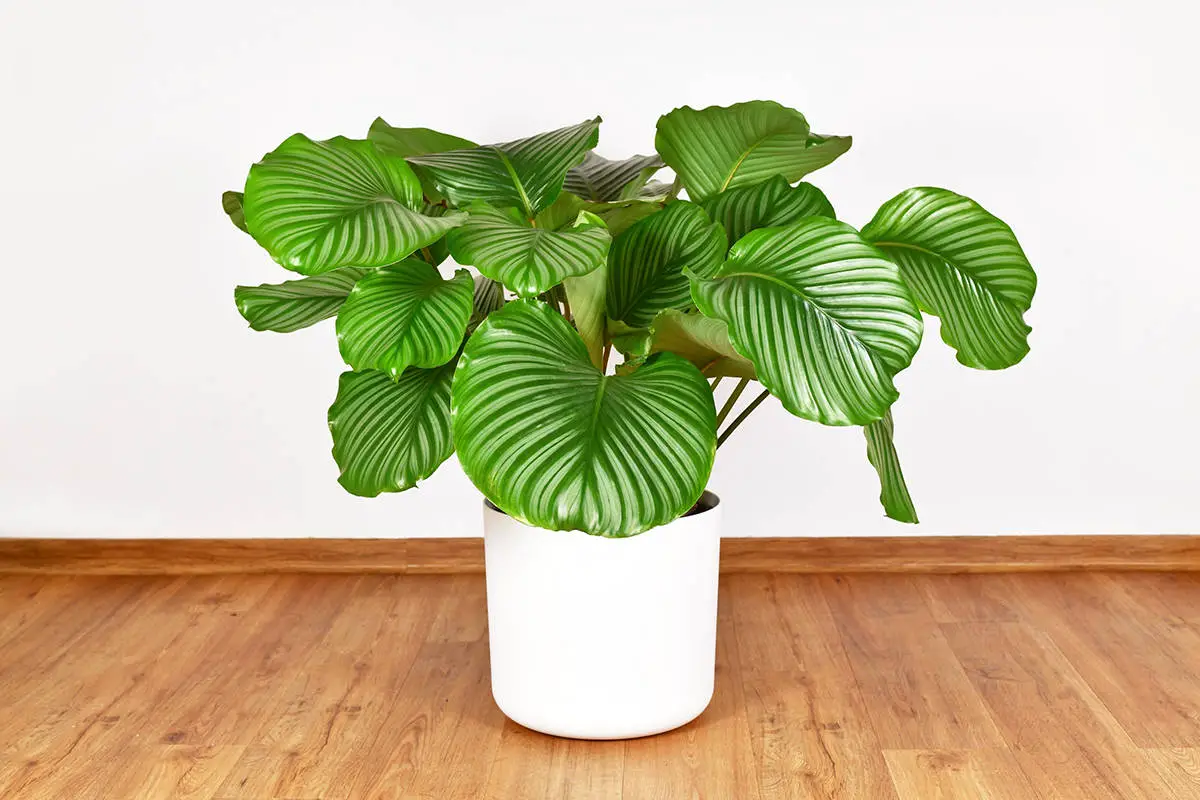
Calathea Orbifolia is a striking houseplant noted for its large, round leaves. Their leaves are a draw with their bold stripes and a glossy finish. They make the plant stand out in your indoor garden. You’ll find the care for this plant similar to that of its relative, the prayer plant.
Keep the soil moist for your Calathea Orbifolia. It thrives in high humidity and prefers indirect light. Avoid overwatering to prevent root rot. A monthly feed with a balanced fertilizer during growing seasons keeps it healthy.
The large leaves gather dust, so you should wipe them gently with a damp cloth. This not only keeps the plant looking fresh but also allows it to breathe better. Watch for pests, like spider mites and scale, which can be a nuisance but are treatable.
For those with a busy schedule, Calathea Orbifolia’s resilience is a bonus. It’s a forgiving choice if you occasionally forget to water or mist it. Yet, remember, consistent care yields the best results.
The plant reaches up to 2 feet, making a statement without overshadowing other plants.
Peace Lily (Spathiphyllum ‘Sensation’)
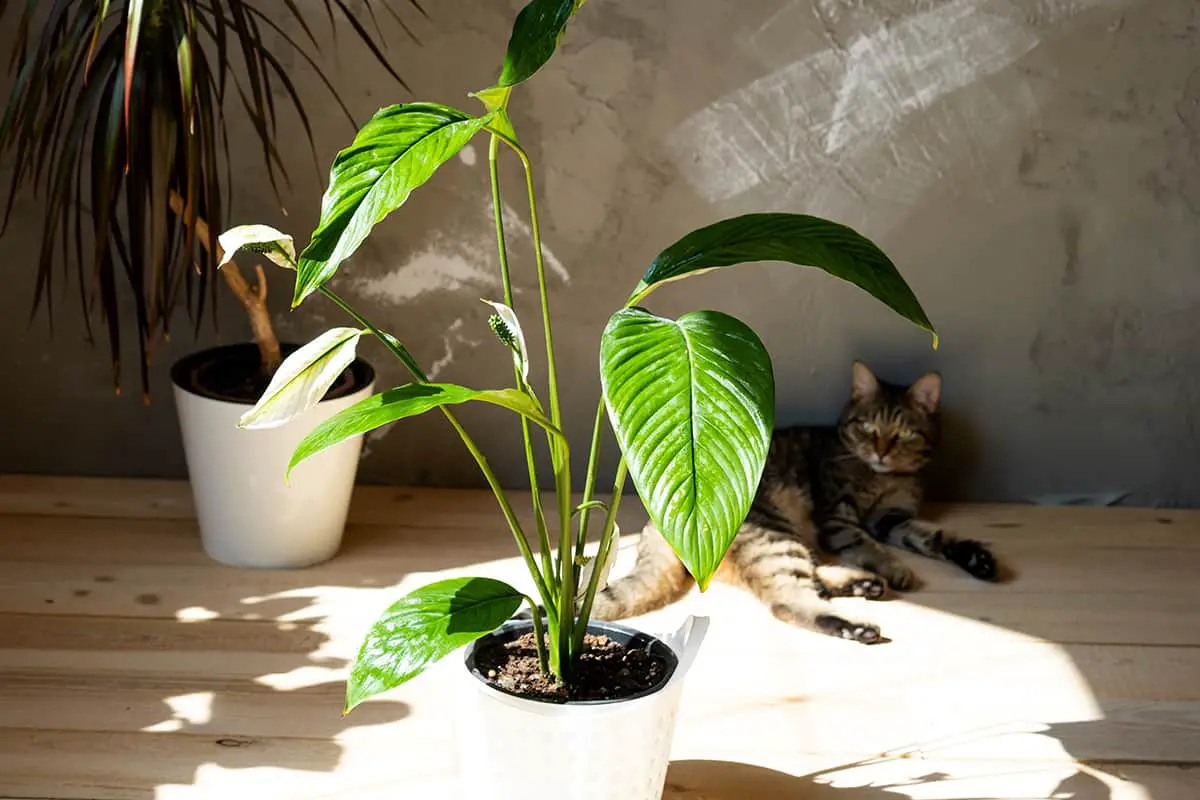
The Peace Lily, known scientifically as Spathiphyllum ‘Sensation’, features large, deep green leaves. This variety of Peace Lily can grow larger than its counterparts. It may reach up to six feet tall under ideal conditions. You have a plant that’s not just eye-catching but also air-purifying.
Your care routine for the Spathiphyllum ‘Sensation’ should include consistent moisture. Yet, avoid overwatering as it may lead to root rot. Bright, indirect light is best for this plant, ensuring growth without scorching the leaves.
In the right environment, your Peace Lily will produce white, hood-like blooms. These contrast beautifully with the dark foliage.
Anthurium ‘Faustino’s Giant’
Anthurium ‘Faustino’s Giant’ is a houseplant with impressive foliage and large, glossy leaves. These leaves can reach significant dimensions.
This plant thrives in bright, indirect light. Overexposure to direct sunlight may harm the leaves, so careful placement is key. Water the plant when the top inch of soil feels dry to the touch.
Humidity is essential for this plant. Like other anthuriums, ‘Faustino’s Giant’ prefers a humid environment. You may mist the leaves or use a humidifier to help it flourish. Ensuring proper humidity helps maintain the plant’s dramatic appearance.
Split-Leaf Philodendron (Philodendron Bipinnatifidum)
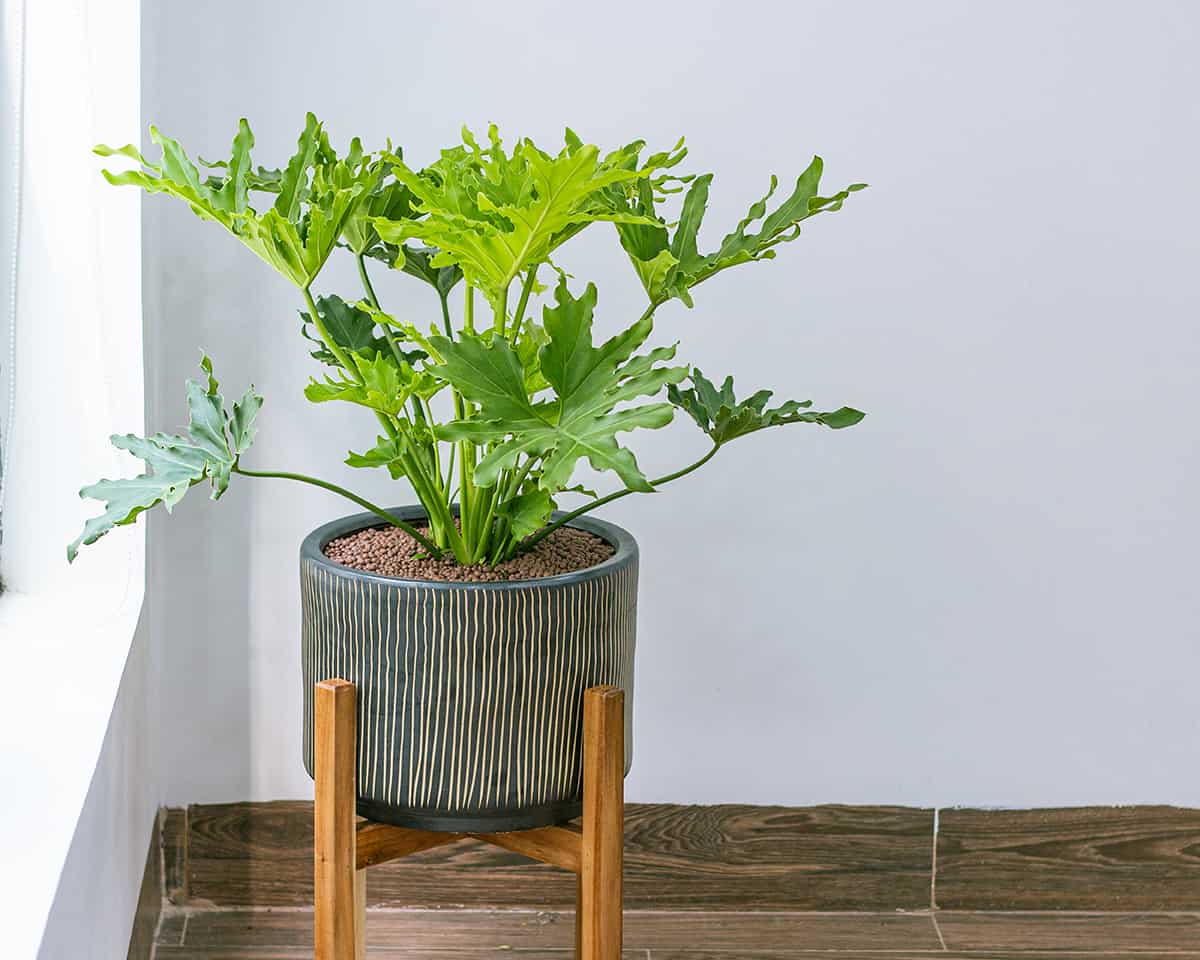
Philodendron Bipinnatifidum, commonly called Split-Leaf Philodendron, is not the same as the Monstera, despite similarity in leaf appearance. Your Split-Leaf Philodendron is an evergreen plant that thrives indoors with the proper care. It boasts large, glossy leaves with deep lobes.
Care for your plant involves providing bright, indirect light. Direct sunlight can burn the leaves. Water the soil when it feels dry to the touch, usually once a week, but avoid over-watering. This plant can grow large, making it a stunning statement in your home.
Known for air-purifying qualities, the Split-Leaf Philodendron helps remove toxins from indoor environments. To maintain its aesthetic, regularly dust the leaves and trim any yellowing foliage.
Cast Iron Plant (Aspidistra Elatior)

The Cast Iron Plant garners its name from its robust nature. It thrives in conditions where other plants might falter. If you seek a resilient houseplant, this evergreen perennial is a fitting choice. Native to Asia, Aspidistra Elatior stands out with its large, dark green leaves.
This plant is a popular choice for indoor spaces due to its minimal light requirements. Plus, the Cast Iron Plant is forgiving when you forget to water it. It withstands neglect better than most.
In your home, give it a spot away from direct sunlight. Its wide leaves grow best in shaded areas. These leaves can also be a deep backdrop for other smaller, flowering houseplants. Over time, it spreads slowly, creating a lush green expanse.
When it comes to care, Aspidistra Elatior requires little effort. Ensure the soil is well-draining and fertile. It’s also resistant to pests, making it even less hassle for you.
Remember to keep the leaves clean. Dust occasionally collects on them. Clean leaves mean a happier plant and a fresher look for your home.
Ruffled Fan Palm (Licuala Grandis)
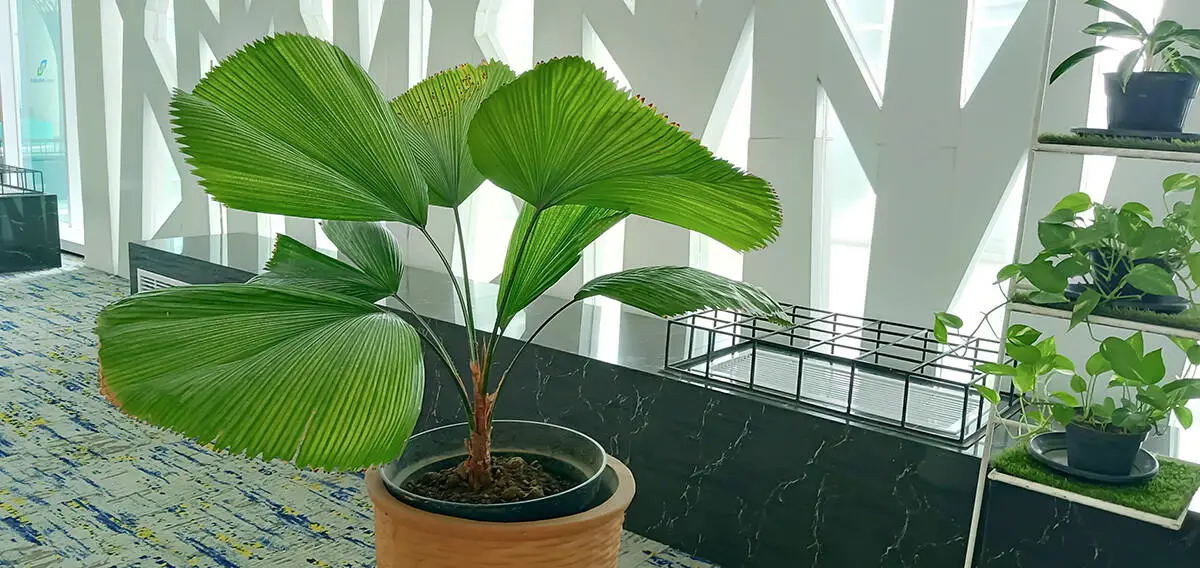
The Ruffled Fan Palm is a stunning houseplant with large, rounded, and fan-like leaves. Their glossy texture and ruffled edges provide a lush, ornamental quality to your space.
This palm thrives when you provide it with a warm, humid environment. It grows well in part shade and requires protection from harsh sunlight. Keeping your Ruffled Fan Palm in the right spot ensures healthy growth. The ideal temperature range is between 65°F to 85°F (18°C to 29°C).
You should water the Licuala Grandis when the top inch of soil feels dry. Overwatering can harm the plant, so ensure proper drainage. The use of a well-drained soil mix helps prevent root rot.
Regular pruning is not required to maintain your Ruffled Fan Palm. Simply remove dead or yellowing leaves to keep it looking its best.
